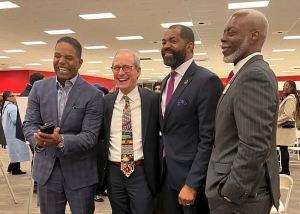Many songs celebrating the holiday are written by African Americans — people we know — and whose music has always given us life.
Christmas Carols, like all hymns, tell the story of our faith and give us an avenue with which to rehearse that faith. Of course, with carols, it’s all about the story of Jesus’ birth, Mary and Joseph, the stable setting, the scholars who dropped by, the animals who held court, and the angels who serenaded the entire company.

Some carols are filled with history and agony, while others are just pure joy. And there’s nothing like the camaraderie that develops while strolling through neighborhoods, struggling to remind each other of the words while freezing your collective rear off.
Carols date back to the 13th century, apparently having flourished under the influence of St. Francis of Assisi. But many have been added to our repertoire and are written by African Americans — people we know — whose music has always given us life. Familiar carols like “Silent Night,” “The First Noel,” “Joy to the World,” and “Away in a Manger “can easily capture our imaginations and our voices, but what about something like “Mary’s Boychild”?
The exact origin of this song is unknown, although it appears to have originated on the South Carolina coastal island of Saint Helena, according to music historians. It has been recorded and re-arranged numerous times since its inception and remains one of the few spirituals that covers the infant Jesus, as most enslaved people preferred to focus on the wonderful, powerful Savior. The verses tell the story with a call-and-response effect. The first declares she had a baby. The second inquires as to his name, and so forth.
“Mary’s Boychild”
“Mary’s Boychild” is written by Jester Hairston, who was born in 1901 in rural North Carolina. Hairston composed more than 300 spirituals, arranged “Amen” for “Lilies of the Field,” and played in the TV show “Amos and Andy.” He is, however, currently best known for his role as Rolly Forbes on the TV show, “Amen.”
“Rise Up, Shepherd, and Follow”
This song is a spiritual rather than a carol. According to the Black Catholic Messenger, it “follows a traditional call-and-response format calling attention to the bucolic scenes of the Gospel of Luke chapter 2, wherein a group of farmers are called to travel to Bethlehem to see the child-king Jesus.” It’s unknown exactly when it was composed but the first-known text version dates to 1891.
“This Christmas”
Written by Donny Hathaway and Nadine McKinnor, “This Christmas” was released in 1970. While it doesn’t mention the birth of Jesus, it is filled with good thoughts of family, friends, and a compelling future. It has been covered by numerous artists and gained great popularity with the movie, “This Christmas.”
“Go Tell it On The Mountain”
This song was written in 1907 by John Wesley Work Jr., considered to be the first Black collector of Negro folk songs. The Fisk University graduate earned a master’s degree and became a Latin and Greek instructor. Negro spirituals were his passion, and to preserve them, around 1889, he organized Fisk University singing groups. The Fisk Jubilee Singers went on to travel the country with their treasure of songs.
“Mary Had a Baby”
The exact origin of this song is unknown, although it appears to have originated on the South Carolina coastal island of Saint Helena, according to music historians. It has been recorded and re-arranged numerous times since its inception and remains one of the few spirituals that covers the infant Jesus, as most enslaved people preferred to focus on the wonderful, powerful Savior. The verses tell the story with a call-and-response effect. The first declares she had a baby. The second inquires as to his name, and so forth.
“Sweet Little Jesus Boy”
This song was written by Robert MacGimsey, who was not African American but wanted the song to appear to have that origin. As the National Baptist Union put it, “MacGimsey wanted “Sweet Little Jesus Boy” to echo the sentiments of Black Christians in the Civil War era. He once described his most famous song as more a meaning than a song: He pictured an aging Black man whose life had been full of injustice “standing off in the middle of a field just giving his heart to Jesus in the stillness.”
“Jesus. Jesus. Oh, What a Wonderful Child”
This song is the last because it’s my absolute favorite. I’ve seen how new worshippers light up and sing heartily once they get the idea of it. It’s a singular crowd-pleaser that creates unity in large worship gatherings.
Written in 1950 and originally known as “Glory to the New Born King,” this popular gospel carol is attributed to Margaret Allison Wells, who grew up in Philadelphia, accompanied worship at her church, and eventually sang with the Angelic Gospel Singers, a group she formed in 1944.
This article was originally published on WordinBlack.com.

The post 7 Christmas carols that bear a touch of soul appeared first on AFRO American Newspapers.











